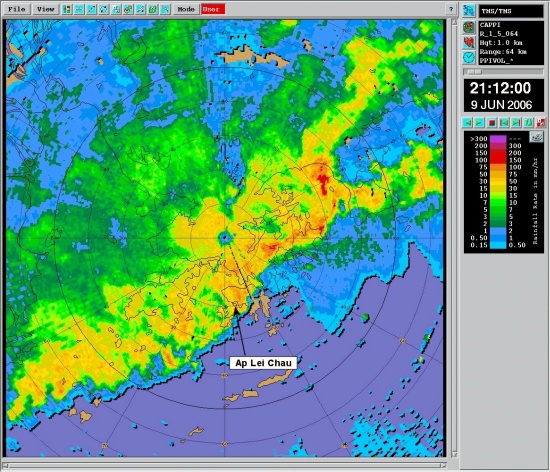Speculations of Tornado and Microburst at Ap Lei Chau and Mid-levels of Hong Kong Island on the night of 9 June 2006
Speculations of Tornado and Microburst at Ap Lei Chau and Mid-levels of Hong Kong Island on the night of 9 June 2006
(14 June 2006)
The Hong Kong Observatory reported that a squall line which swept across Hong Kong on 9 June 2006 with peak gusts of 77 and 101 km per hour recorded at Central and Shek Kwu Chau respectively was responsible for the reports of very high winds at Ap Lei Chau and mid-levels of Hong Kong Island on that day. About 20 trees were blown down at Ap Lei Chau. The Hong Kong Observatory said that there were no evidence to support speculations that a tornado or a waterspout or a microburst had occurred.
The Observatory examined all available meteorological data and carried out a site inspection at Ap Lei Chau before making this conclusion.
A squall line is a narrow band of thunderstorms. It travels fast wrecking havoc on its way. Apart from heavy rain and thunder, a squall line also brings a sudden change in the wind direction and an abrupt increase in wind speed.
Gusts exceeding 100 kilometres per hour are not uncommon in Hong Kong. They are very often mistakenly reported by unexperienced observers as "tornadoes".
Under the influence of an active trough of low pressure, the weather on 9 June 2006 was unstable with heavy rain and squally thunderstorms. On that night, a squall line oriented from southwest to northeast developed over the Pearl River Estuary and moved southeastward across Hong Kong at a speed of about 50 km per hour between 8:30 p.m. and 9:30 p.m. (see Figure 1). Behind the squall line, the colder air descended from above and spread forward on hitting the ground. Figure 2 shows the radar picture shortly after the squall line crossed Ap Lei Chau.
Tornadoes and waterspouts could be detected by a Doppler weather radar. None was detected by the Doppler weather radars at Tai Mo Shan and Tate's Cairn. Furthermore, no funnel cloud characteristic of tornadoes and waterspouts was reported by local residents.
A microburst is a column of cold air descending from a thunderstorm and spreading out in all direction on hitting the ground. However, based on the pattern of fallen trees at Ap Lei Chau and eye witness reports, winds there blew in a uniform direction throughout the event, which did not support the existence of a microburst.
Other examples of severe squall lines previously reported in Hong Kong are: 9 May 2001 and 9 May 2005.
Some information on the characteristics of squall lines and the event on 9 May 2005 are available from the links below:
http://www.weather.gov.hk/en/wxinfo/news/2005/pre0509e.htm
http://www.weather.gov.hk/education/edu01met/wxphe/ele_squalle.htm

Figure 1 The locations of the squall line (dash lines) and the maximum gust (km per hour) recorded at several automatic weather stations during the passage of the squall line on the night of 9 June 2006.

Figure 2 The radar image captured by the Doppler weather radar at Tai Mo Shan at 9:12 p.m. on 9 June 2006. The squall line has just passed Ap Lei Chau and rain started falling there.